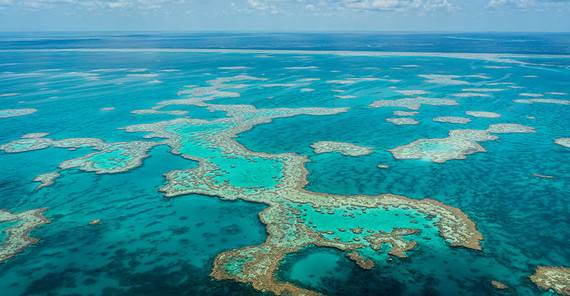They shine in bright colors, form compact spheres, delicate branches, or saucer-shaped plates. The variety of colors and shapes of corals probably inspires everyone who sees them. Most coral species are native to tropical seas, where they form mighty reefs - and have done so for about 400 million years. The colony-forming cnidarians have become the focus of climate research in recent years. On the one hand, because climate change is endangering their existence, on the other, because the calcareous skeletons form natural climate archives. Similar to tree rings, ice cores, or lake sediments, fossil corals can be used to reconstruct the climate history of the Earth.
The environmental physicist Mudelsee is interested in the information that can be extracted from such climate witnesses. “Coral skeletons contain limestone that binds oxygen,” he explains. It is precisely this oxygen that is the key to the past. It occurs naturally in different forms - so-called isotopes. If researchers determine the ratio of two specific isotopes - 16O and 18O - they can deduce which climatic conditions prevailed when the oxygen atoms were incorporated into the coral's skeleton during its lifetime. Regardless of whether this was 10,000, 200,000 or three million years ago.
Skimming as much information as possible
For climate researchers, such data are a real goldmine. Corals allow a particularly far-reaching look back into the tropical climate history of several million years. In addition, the growth rings of the fossils provide very precise information about the year and seasonal fluctuations. This data can also be used to identify extreme weather events such as heat waves or past weather phases with particularly high precipitation.
The problem is that you first have to find fossil corals with an age of several million years. Discovering them is not that easy. “The data situation is therefore relatively poor,” Mudelsee explains. His colleagues undertake long and costly expeditions with research ships to find and recover the right samples. “But such journeys are not really my thing,” says the researcher with a wink. “It’s important to know where the samples come from or how they are measured. But I’d rather sit at my desk in front of the computer and develop methods to best analyze this data.”
The mathematics behind climate reconstructions is his passion. Mudelsee develops the appropriate algorithms and computer programs to extract as much information as possible from the available data. After his doctorate in paleontology, he learned the necessary tools for this –statistics – “from scratch” during a research stay at the University of Kent in Canterbury as a postdoc.
Extreme events are expensive
“I sit here and program,” says the environmental physicist and statistician about his work in the SEARCH research project. But, of course, there is much more to it. Mudelsee collects and archives data from the scientific literature and from current measurements, develops and tests various analytical tools to find the most suitable and accurate method, translates the isotope signals from the chemical analysis of the corals into climate signals and finally determines trends and seasonal cycles: What was the water temperature in the lifetime of the analyzed corals? What maximum and minimum temperatures were they exposed to and how rapidly did these conditions change? Finally, the researcher compares the data from earlier warm periods with measurements from the current Anthropocene to analyze differences and similarities and make predictions. “We already have a rough overview of climate history, but now we are picking up the magnifying glass and looking even more closely into the past,” he says.
The researcher is particularly interested in extreme events during past warm periods - such as in the Pliocene around three million years ago - rapid temperature fluctuations or large changes in precipitation totals. “The average rise in temperature is not so crucial,” Mudelsee says, explaining climate research’s interest in such outliers. “But the extremes will increase and cause great damage.” For insurance companies, businesses, and society, such events are expensive. Understanding and assessing them better is therefore not only scientifically interesting.
We have to adjust
“We are currently experiencing very rapid, far-reaching changes due to humans,” Mudelsee explains. “Were there comparable phenomena and phases in the past in which things happened similarly quickly? And how did biological systems respond?” High-resolution data, such as those provided by fossil corals, are necessary to detect these seasonal extremes in the past.
Mudelsee looks at his field of research with the sobriety of a scientist. “For a start, I don’t care what the result is. I serve climate science best when I approach the questions in an unprejudiced way.” Nevertheless, climate change is a highly relevant political and social issue. “Of course, I am also concerned about climate change and how fast it happens,” says Mudelsee “It will no longer be enough to just focus on avoiding emissions. We also have to adapt to climate change.” Since 2005, he has kept a close eye on climate risks not only as a researcher but also as an entrepreneur: His company “Climate Risk Analytics” advises stakeholders from politics, business and the public sector and teaches mathematical methods for data analysis, on which he has also published two textbooks.
Besides climate history and statistics, Mudelsee also has another passion: chess. "I played so much chess that I finished my studies relatively late. Fortunately, I eventually got my act together," he says with a laugh. "Analyzing data is my strength. And there are definitely parallels between chess and science."
The Researcher
Dr. Manfred Mudelsee studied physics at Heidelberg University. Since 2022, he has been a research scientist at the University of Potsdam. He holds the chess title of a FIDE Master and in 2005 founded the company “Climate Risk Analysis”, which is working on risk quantification and data analysis of extreme climate or weather events.
Email: mudelseeuclimate-risk-analysispcom
The Project
“SEARCH (Seasonal Extremes and Rates of Change in Past Warm Climates: Insights from Advanced Statistical Estimations on High-Resolution Coral Proxy Records)” is one of 19 sub-projects of the Priority Program “Tropical Climate Variability and Coral Reefs. A Past to Future Perspective on Current Rates of Change at Ultra-High Resolution” funded by the German Research Foundation (DFG). It aims to enhance our current understanding of tropical marine climate variability and its impact on coral reef ecosystems. The sub-project SEARCH analyses past climatic conditions and weather extremes with the help of statistical analyses and simulation methods. Analyzing the climate of past warm periods, after all, may provide a better understanding of potential future climate developments under climate change.
Duration: 2022–2025
Participating institutions: Alfred Wegener Institute, Helmholtz Center for Polar and Marine Research (AWI), Potsdam, Freie Universität Berlin, GEOMAR Helmholtz Centre for Ocean Research Kiel, Helmholtz Centre Potsdam - GFZ German Research Centre for Geosciences, Potsdam, MARUM Center for Marine Environmental Sciences, University of Bremen, Max Planck Institute for Chemistry, Mainz, University of Bremen, Goethe University Frankfurt, University of Giessen, Heidelberg University, Kiel University, University of Konstanz, Leipzig University, University of Mainz, University of Potsdam, Leibniz Center for Tropical Marine Research, Bremen
www.spp2299.tropicalclimatecorals.de
The Pliocene – Blueprint for the Future?
The Pliocene began about five million years ago and ended about two and a half million years ago. Some climate researchers believe that a similar climate could prevail on Earth in the future as it did back then. This is because the CO2 concentration then was between 380 and 420 ppm, which is similar to the recently measured value of 419 ppm. The average global temperature, however, was about 2 - 4 degrees higher than today, Greenland was free of ice, and the sea level about 20 meters higher.
This text was published in the university magazine Portal Wissen - One 2023 „Learning“ (PDF).


